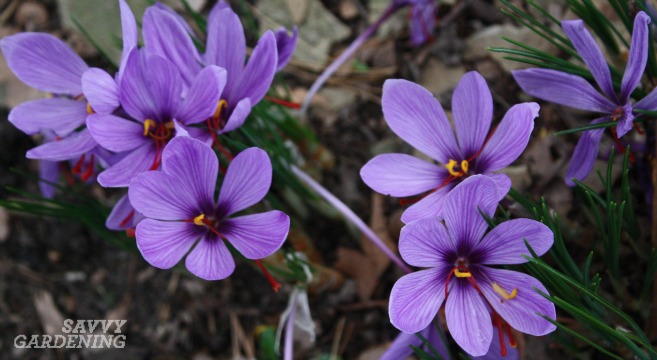This post may contain affiliate links. If you make a purchase through links on our site, we may earn a commission.
First cultivated in the Mediterranean region, saffron is, by weight, the most expensive spice in the world. It comes from the saffron crocus, Crocus sativus. Considering the high price this spice fetches at market, you might be surprised to discover how easy it is to grow.
How to grow saffron crocus
- The fall-blooming, purple-flowered saffron crocus grows from a bulb-like structure called a corm. The corms are planted in the spring or early fall.
- Saffron crocus smells a little like vanilla and spice, and the dried stigmas add a distinct flavor to foods like Spanish paella, rice dishes, and bouillabaisse.
- To plant saffron crocus, start with high-quality corms. They can be purchased for a reasonable price from several different online companies, including Nature Hills Nursery and Brent and Becky’s Bulbs.
- Chose a planting site that is very well-drained and has soil rich in organic matter.
- Plant the corms in spring or in the early fall, to a depth of about four to six inches.
- Once planted, you won’t see anything sprout from the bulbs until late fall.
- When the flower comes into bloom in the autumn, the elongated, orangeish-red stigmas are plucked from the flower. The flowers are small, and the stigmas are like little orange threads, making harvesting large quantities of this spice quite time-consuming (hence, its hefty price).
- Spread the harvested stigmas on a cookie sheet to dry in a warm room until they easily crumble.
- Each bulb produces one flower and each flower produces three stigmas.
- As soon as the flowers fade, you can gently dig up the crocuses and separate the bulbs, replanting them immediately. Doing this yearly quickly results in a large colony, but if you only want to take on this task every three or four years, that’s okay. Just remember to divide them before the corms become over-crowded and production is affected.
- Saffron crocuses are hardy down to -10 degrees F. If you live in a region where temperatures regularly dip below that limit, be sure to mulch the planting site with several inches of straw or compost soon after the plants are finished blooming.
- When stored in an air-tight container, dried saffron remains fresh for up to two years.
Do you grow saffron crocus? Share your experiences in the comment section below.
Pin it!




I always had it in my head we couldn’t grow saffron crocus here. I’ll certainly look into for the future. Thanks for the info
Does anyone know what kind of fertilizer the saffron crocus need? Mine quit blooming after two years and the fertilizer I have does not help
Hi Dennis. You could use any bulb-specific fertilizer on your saffron crocus, but if they haven’t bloomed in a while, it’s probably time to dig them up and divide them. Saffron crocus seem to need divided more frequently than some other bulbs. Also, maybe they need a bit more sun?
My crocuses and other bulb flowers quit blooming after a year or two because of a high clay content in the soil, so incorporating compost into their soil helps.
My mother used to grow saffron, but I don’t remember purple crocus flowers. The orange threads were very similar. Is there any other flower that you use the threads from that is similar to saffron?
Thanks, Cathy
Not that we know of.
Does anyone have detailed instructions on how to container saffron. I live in Denver. Planted in milk crate. Don’t know how to deal with winter. Pull in garage. Water. Any light. Planted oct 3
I would put the crate in a protected area that stays just above freezing. An unheated garage or root cellar would be best. Water every six weeks and move back outdoors in the spring. They won’t show their faces until the following fall, but that should show them safely through the winter.
After reading your directions I think I would like to try to do this this spring and have them ready for the fall. I thank you for the interesting tips and I hope it works out for me. Tina
We grow saffron in Northwest Ohio, 100 bulbs this past fall gave us about 2.5 grams of saffron after harvest. Heavy clay soil amended with compost from goat and chicken droppings and bedding. We’re waiting for the frost to dig up the bulbs and separate them, hoping to increase the harvest next year.